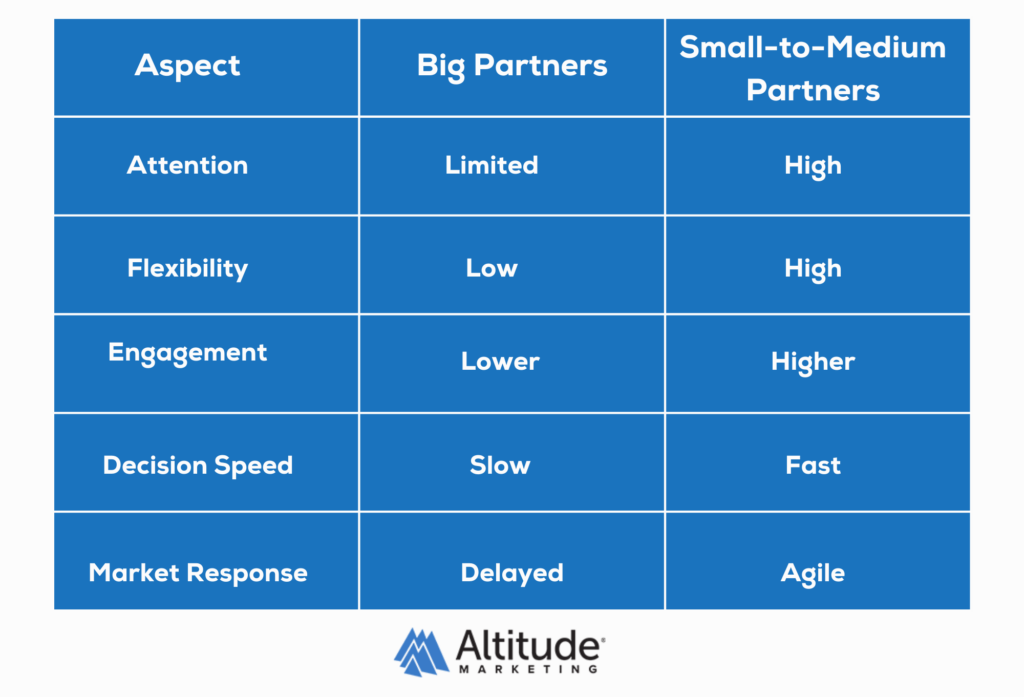In 2025, partner marketing is set to play an important role in business growth, with 85% of companies viewing partnerships as a key driver of success. By collaborating with other businesses, you can extend your reach, share resources, and build stronger customer trust.
Whether you’re co-creating content, hosting joint webinars, or launching referral programs, partner marketing offers a powerful way to unlock new revenue streams and strengthen your market position. Dive into this guide to harness the full potential of collaboration.

Partner Marketing: A Complete Guide (2025)
What Is Partner Marketing?
Partner marketing involves two companies collaborating to achieve mutual goals, usually by promoting each other’s products or services. This can take various forms, such as co-branded content, joint webinars, or referral programs. In 2025, partner marketing is not just about increasing sales – it’s about strengthening relationships, building trust, and scaling your marketing reach.
Types of Partner Marketing
- Co-Branded Content: Two brands come together to create content that highlights both their offerings.
- Joint Webinars and Events: Hosting a webinar or event together to reach a combined audience.
- Referral Programs: Incentivizing customers or partners to refer new clients.
- Affiliate Marketing: A partner promotes your product in exchange for a commission.
Key Benefits
- Extended Reach: You tap into your partner’s customer base.
- Shared Resources: Co-marketing reduces costs by sharing creative, marketing, and operational resources.
- Increased Trust: Customers trust a product endorsed by a brand they already know.
The Importance of a Strong Better-Together Story
Your “better-together” story is the foundation of any partner marketing strategy. It outlines why your partnership adds value for the customer, and why the collaboration is stronger than either company acting alone. A clear, compelling better-together narrative helps potential customers understand how your products or services complement each other and create a seamless solution that addresses their specific needs.
Building a Strong Value Proposition
Crafting this story requires highlighting the unique strengths each partner brings to the table. Consider the following questions to build your narrative:
- How do our products or services work together?
Define how the integration or collaboration enhances the customer’s experience. - What problem does our partnership solve for the customer?
Clearly articulate the pain points that your joint solution addresses. - How can we communicate this across all marketing materials?
Ensure consistency in messaging through all joint campaigns, emphasizing the combined value proposition.
How to Build Effective Partner Marketing Programs
Building a partner marketing program involves careful planning and execution. Here are the steps to get started:
Setting Goals and Objectives
Before diving into partner marketing, define clear goals. These might include:
- Increasing revenue by X%
- Entering a new market
- Enhancing brand awareness
Researching and Selecting Partners
Choose partners whose offerings complement your own. Look for companies with shared target markets and values. Research potential partners through networking, industry events, or even by evaluating competitors.
Creating Joint Marketing Strategies
Once you’ve selected a partner, it’s time to create a co-marketing plan. This could involve:
- Joint Webinars: Educating both audiences about how your products work together.
- Co-Branded Content: Articles, eBooks, and case studies that feature both companies.
As you build your partner marketing program, it’s important to explore strategies that go beyond the basics. By implementing innovative approaches, you can maximize the impact of your partnerships. Here are some additional insights to consider for taking your partner marketing efforts to the next level:
Aspect | Unique Insight | Actionable Tip |
Cross-Industry Partnerships | Partner with companies from unrelated industries to tap into new customer bases. | Identify industries where your product can complement an existing need. |
Joint Innovation | Co-create new products or services, not just campaigns. | Brainstorm with partners to develop entirely new offerings. |
Data Sharing | Share customer insights for more personalized marketing. | Use shared CRM tools for better audience targeting and messaging. |
Sustainability Focus | Collaborate on eco-friendly initiatives to attract conscious consumers. | Highlight joint sustainability efforts in marketing materials. |
Localized Campaigns | Customize partner marketing for regional audiences. | Develop campaigns that address local cultural preferences. |
By applying these advanced strategies, you can deepen your partner relationships, unlock new growth opportunities, and ensure that your co-marketing initiatives remain relevant and impactful.
Partner Enablement and Support
To succeed in partner marketing, it’s essential to equip your partners with the tools and knowledge to market your products effectively. The foundation of a successful partnership lies in empowering partners with the right resources and support.
Training Your Partner's Sales Teams
Provide comprehensive training sessions that teach your partner’s sales teams about your product or service. Interactive product demos are particularly effective, allowing partners to experience how your product works firsthand. This practical exposure not only enhances their understanding but also boosts their confidence when presenting your offerings to customers.
Best Practices for Support
Offer sales enablement materials, such as pitch decks, brochures, and training videos, to ensure that partners have access to valuable resources. Additionally, create campaign-in-a-box solutions that your partners can use to promote your joint offerings. This streamlined approach simplifies execution and maximizes impact.
Managing and Measuring Partnerships
Effective partner marketing requires ongoing management and evaluation. Tracking performance metrics helps ensure that your partnership is successful and scalable, allowing for data-driven decisions that enhance collaboration.
Tracking Success
Key performance indicators (KPIs) for partner marketing include:
- Leads generated: Number of qualified leads coming from the partnership.
- Revenue contribution: How much revenue is generated from joint marketing efforts?
- Customer satisfaction: Feedback from customers who purchase through partnerships.
Ongoing Communication
Maintain open communication with your partners. Schedule regular check-ins to discuss performance, review KPIs, and make adjustments to your co-marketing strategies. This proactive approach fosters a culture of transparency and collaboration, ensuring that both parties are aligned in their objectives.
Maximizing Small-to-Medium Partnerships
While large partnerships with big players may be tempting, small and medium-sized partners often provide more personalized attention and greater flexibility, leading to unique opportunities for growth.
The Power of Small Partners
Smaller companies are often more eager to collaborate, leading to higher engagement and commitment. For example, smaller partners are more likely to invest time in joint webinars or co-branded content, creating meaningful interactions that resonate with audiences. Leveraging their agility can help both parties respond quickly to market changes and customer needs.
To better understand the distinct advantages that small-to-medium partners offer compared to larger counterparts, let’s explore a side-by-side comparison of their key characteristics.

This comparison highlights how small-to-medium partnerships can provide unique advantages through personalized engagement, flexibility, and agility, making them a strategic choice for sustainable growth.
Leveraging Channel and Referral Marketing
Channel and referral marketing are powerful methods for scaling your partner marketing efforts. Channel marketing helps you promote products across different platforms, while referral programs incentivize partners to generate new leads, expanding your reach effectively.
Channel Marketing
Popular marketing channels include:
- Social Media: Co-promote content across both companies’ social media platforms to maximize visibility.
- Email Campaigns: Send joint newsletters or promotional offers to engage existing customers.
- Paid Advertising: Create joint ads that leverage the audiences of both partners, enhancing reach and credibility.
Referral Programs
Offer incentives for partners to refer clients to your business, such as discounts or commissions. This creates a win-win scenario, where partners are motivated to drive new business while also benefiting from their efforts.
Budgeting for Partner Marketing
Effective partner marketing requires allocating resources properly. Budget for joint initiatives, co-branded events, and lead-generation activities to maximize your investment and ensure successful outcomes.
Allocating the Right Resources
Set aside a specific budget for each partnership initiative. As a rule of thumb, 25% of your marketing budget should be allocated to partner marketing if you’re actively pursuing this strategy. This ensures you have the necessary resources to implement effective campaigns.
Safeguarding for Flexibility
Keep a small portion (around 5-10%) of your budget flexible for unexpected partnership opportunities or extra initiatives with your top-performing partners. This flexibility allows you to capitalize on emerging trends or fruitful collaborations without straining your overall budget.
Publicizing Your Success
Documenting and sharing your wins will help sustain partnerships and attract new ones. Sharing metrics and results not only motivates partners but also shows the value of the partnership to internal stakeholders.
Showcasing Wins
Highlight joint wins through case studies, press releases, and internal reports. Showcase metrics such as:
- ROI from joint campaigns
- Leads generated from co-marketed content
- Conversion rates from webinars
Strengthen Your Business with Partner Marketing
Partner marketing is an essential tool for business growth in 2025. By building the right partnerships and creating effective co-marketing strategies, you can reach new audiences, increase trust, and boost sales. Focus on clear objectives, strong collaboration, and creative joint efforts. Start today to open up fresh opportunities and drive long-term success through impactful partnerships.
FAQs
What is B2B partner marketing?
B2B partner marketing involves two businesses collaborating to promote each other’s products or services, sharing resources and audiences to achieve mutual goals, like increasing reach and driving sales.
What is a partner marketing specialist?
A partner marketing specialist manages collaborations between businesses, creating co-marketing strategies, coordinating campaigns, and ensuring both parties benefit from the partnership by increasing brand visibility and driving revenue.
What is the difference between partner marketing and affiliate marketing?
Partner marketing involves two businesses working together to promote each other’s products, while affiliate marketing involves a third party earning a commission by promoting a business’s products to its audience.
Is channel marketing the same as partner marketing?
No, channel marketing focuses on distributing products through various third-party channels, while partner marketing involves businesses collaborating to promote each other’s products or services through joint marketing efforts.
What does a director of partner marketing do?
A director of partner marketing leads partnership strategies, manages relationships, oversees co-marketing campaigns, and ensures the partnership drives growth, revenue, and market reach for both companies involved.
Ready to elevate your B2B marketing?
We help leading business-to-business brands hit their marketing goals. Get in touch to learn how Altitude Marketing can help you reach your peak performance.




